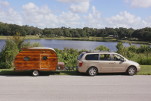Well, I'll jump in on this thread. While our TD is in the very, very earliest of building stages we spend a substantial amount of time camping around the country. Many people do not realize the fantastic opportunities that exist outside of private areas. BLM (Bureau of Land Management) is primarily a western U.S. concept and National Forests are everywhere, but a substantial portion of the west comes under the guise of "public lands" and many locations in the east. NF and BLM rules are pretty straightforward, unless posted or fenced, you are allowed to camp in a dispersed manner in most places, at no cost. Yes, this means no amenities, such as water or power. However, many of these locations also have developed campgrounds which will usually have a small fee associated. That does not mean they provide the "goodies", just a developed area with some form of toilet and maybe water and/or power. Other Federal camp grounds may well have full amenities, even as far as cable.
The beauty of BLM and NF (and also Corps of Engineers -COE) is that you can get to some absolutely amazing locations, have no hassle with neighbors, no loud generators, no wheel of fortune tv and often at no cost. Muley Point and Valley of the Gods are two such locations in southern Utah, Angel Peak in New Mexico. Vistas and scenery you cannot imagine and the cost is great - FREE. Want some goodies? Valley of Fires BLM in central New Mexico has full hookups, a fantastic, modern bath house with laundry and overlooks the Valley of Fires recreation area which is a massive, ancient lava flow, cost runs anywhere from $15-$25. While campers in the Grand Canyon are sardined into the few allowed spots, go 8 miles south the the NF Ten-X campground and you'll love it. Middle of a forest, no electricity, but water is available and outhouses. Cost is about $15 and no hassles. Visiting the GC is very easy. Do the north rim of the canyon and stay in the NF campground and you'll love it.
Just outside of Mt. Rushmore is Horsethief Lake campground (NF). Halfway between Yellowstone and Cody are several BLM and NF campgrounds, Wapiti is my favorite. Camping right on the river, full hookups about $25. Going down I-70, before you get to Grand Junction, Colorado, there are several stop-in BLM locations, right on the river cost runs from free to $10.
COE areas are a very special group. In many cases they have full hookups and are always associated with water, be it a huge reservoir or the Mississippi. Some places, like Ridge Road in Georgia have campsites that are all at least an acre in size and all waterfront. Cost is around $20. You'll find COE in almost every state.
National Park campgrounds? To be honest, I find them more of a PITA and unless I absolutely have to use one, I won't. "Campers" are squished in as tight as possible. Places with hookups are often nothing more than parking lots. You are often stuck right between 2 giant RVs. Not my cup of tea.
So what about safety? I can honestly say I've never had a problem. Not saying it can't happen, as it does, but for the most part if you are safe and understand your area, then you'll be fine. I don't carry guns (don't need to) and my dog is too old to scare anyone. Just don't leave expensive stuff laying around and in view. A thief is by definition "lazy", they aren't going to work hard for something when they can get the same thing easier.
So when it comes time later this year (I hope) to take the new trailer for it's run, we'll be going back out west and probably be gone for over a month. Oh, but we do have one rule of thumb, every 10 days we stay in a motel for a night. Roughing it is fun, just not as a lifestyle for this old guy.
Main BLM site - enter the word "camping" into the search box and then go from there
http://www.blm.gov/wo/st/en.html
National Forest Service site - this one is kind of weird. Figure out an area you want, say Colorado. Zoom in on the area first, then choose a ranger district. Go to that district page and usually you'll find the "Recreation" menu. Camp sites may or may not be listed, but after a bit of prospecting you'll figure out how they do their stuff. Yes, it is almost like they don't want you to find stuff.
http://www.fs.fed.us/locatormap/
Corps of Engineers - Camping website. The COE's layout is probably the best and most straightforward. However, be aware that many of the areas you find will be controlled by private contractors and in many of the other areas there is little info on the site. Some will have full photos
http://corpslakes.usace.army.mil/visitors/camping.cfm
This site is very informative, RV Park Reviews. I find most of the info pretty good, but you do have to toss out many of the super high and super low comments and read what type of "camper" was being used.
http://www.rvparkreviews.com/
This is another site that I really like, as you can often see exactly the location you are considering before you get there.
http://www.campsitephotos.com/
EDIT - I've added in a zip file in the below link. This contains pretty much the locations and information on every campground in North America. The zip file contains 6 csv files that will work with most GPS units and anything that reads "Comma Separated" files, like an Excel spreadsheet. Each file is a specific geographic region of the U.S. or Canada. Each region holds hundreds of locations. Each location is set by digital Lat/Lon, location names, phone numbers, amenities, costs, etc. This has been compiled by numerous organizations over many years and is often updated. Most is very accurate, but in something of this size, it can become outdated in some areas.
http://www.passagetoproductions.com/cam ... undsNA.zip
This is the link to the original campfone website with detailed instructions on how to use the files and access to other types that can be imported into most mapping software products
http://campfone.info/statemaps.html
The main campground website over 13,000 campgrounds - http://www.uscampgrounds.info/
dave
What kind of campsite for a Teardrop?
52 posts
• Page 4 of 4 • 1, 2, 3, 4
Re: What kind of campsite for a Teardrop?
Last edited by daveesl77 on Tue Feb 03, 2015 7:35 pm, edited 3 times in total.
*******
Dave and Regina - Enjoying old age, a LOT!
Build Journal - http://www.tnttt.com/viewtopic.php?f=50&t=62386
Dave and Regina - Enjoying old age, a LOT!
Build Journal - http://www.tnttt.com/viewtopic.php?f=50&t=62386
-

daveesl77 - Donating Member
- Posts: 871
- Images: 273
- Joined: Tue Jan 27, 2015 4:33 pm
- Location: Pocahontas County, West Virginia
Re: What kind of campsite for a Teardrop?
Thanks for the great links, Dave. I'm always looking and dreaming of the trips to come....!
Liz
Liz
-

minstrel - Teardrop Advisor
- Posts: 77
- Joined: Sun Jan 18, 2015 11:49 am
- Location: Northern Arizona

